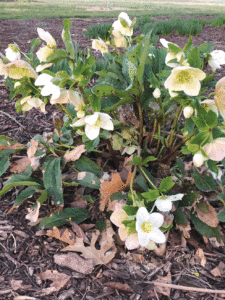
Lenten roses love to grow in humus-rich, well-drained soils, and once established, they are fairly drought-tolerant. (Photo by Ginny Rosenkranz)
Lenten roses, Helleborus orientalis, are perennial flowering plants that thrive in shady gardens on the Eastern Shore.
They prefer the light shade provided by deciduous trees (trees that lose their leaves in the fall) but can often tolerate a sunny garden spot.
Lenten roses love to grow in humus-rich, well-drained soils, and once established, they are fairly drought tolerant, but they never grow well in wet or soggy soils.
Adding a layer of mulch will keep the weeds away and help maintain soil moisture.
Protection from strong winter winds will help keep the foliage from becoming torn and tattered.
The dark shiny evergreen leaves have a leathery texture and grow in a low mound about one foot tall and wide, and are very seldom bothered by either deer or rabbits.
Leaves are shaped like a small umbrella, and become a wonderful frame for the flowers.
The flowers spring up in the early winter and by March should be in full bloom.
Flowers are cup shaped on a stem that bends slightly so that the rose like flowers face downwards.
Most of the newer cultivars have the flowers facing to the side instead of downward, but both are equally lovely.
The colors of the flowers range from pure white, pink and shades of red.
As the flowers mature they often turn shades of green or shades of purple.
Some cultivars are edged with a darker or brighter color, and some even have spots on the inside of the flowers.
Some of the new cultivars have semi double to double petals, creating even more beautiful flowers.
If the leaves look too tattered after the winter, trim them off leaving only the newly emerging leaves and flowers.
Lenten Roses make a wonderful groundcover with their shiny evergreen leaves and the bonus of a beautiful rainbow of colorful flowers that start blooming from January through May.
(Editor’s Note: Ginny Rosenkranz is a commercial horticulture specialist with the University of Maryland Extension.)



